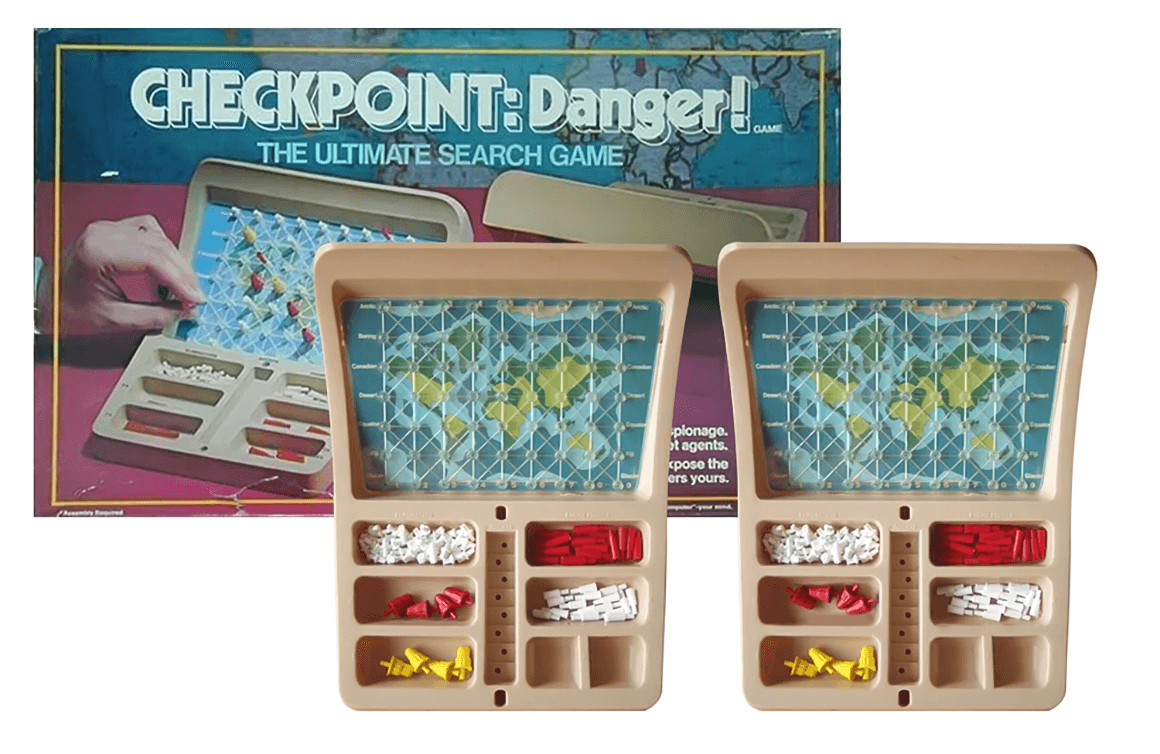“The Ultimate Search Game!”
Released in 1978 by Ideal, CHECKPOINT: Danger! enticed players into the cloak-and-dagger world of secret agents.
CHECKPOINT: Danger! had a similar play pattern to Battleship from Milton Bradley. Players took their best guesses and made strategic moves in an effort to locate the opponent’s assets and eliminate the threat.
GAMEPLAY
The game started with a simple set-up: each player took their global scanner unit (playing board), removed the plastic lid that kept the board and pegs together when stored, and re-purposed it as a game stand. Then, players “hid” their 4 secret agent pegs on the world map located at the top portion of their boards.
The locations on the world map were labelled Arctic, Bering, Canadian, Desert, Equator, Fuji, and Glacier (A to G) running down the sides of the map. The top and bottom of the map were labelled 1 through 9. The red player always makes the first move in CHECKPOINT: Danger!
Players took turns calling out coordinates in hopes of successfully locating their opponent’s secret agent pegs. For example, the “attacker” could call out “Glacier 8” and the opponent would check their board to see if the attacker correctly guessed the area in which an agent was located.
Unlike the Battleship game, however, CHECKPOINT: Danger! wasn’t simply a “hit” or “miss” response. Players used line-of-sight to indicate the proximity of a guess to their agents’ locations. Players checked horizontally, vertically, and diagonally on the world map and were required to indicate how many agents could be seen from the checkpoint of the attacker. Players responded to guesses by saying “miss” 1, 2, 3, 4, or “hit”.
A miss resulted in the attacking player placing short, white eliminator pegs on their world map along all the lines of sight to indicate the unsuccessful play. If the response was 1, 2, 3, or 4, the attacker placed a numbered probe peg indicating the number of agents within the line of sight. Both these types of responses allowed the attacker to make a more strategic guess during their next play in hopes of finding an enemy agent. A hit indicated an agent was found and the player then “crowned” their compromised agent with an enemy agent peg. “Checkpoint: Danger!” was declared aloud when the attacking player deduced an enemy agent hiding at the same coordinates as one of their own agents.
The game promised “thrills and suspense” as players took turns calling and responding. The first player to eliminate all 4 of the opponent’s agents was declared the winner.
IN THE BOX
A complete game included 2 plastic global scanner units (each features a world map on the upper portion of the unit, moulded compartments for peg storage on the lower portion, and a lid), 16 secret agent pegs (8 red and 8 yellow), enemy probe pegs (white), numbered probe pegs (red and yellow), and eliminator pegs (short white). A tri-fold instruction booklet was included.
Note: If you buy something using the eBay link in this story, we may earn a small commission. Thank you for supporting independent toy journalism!

